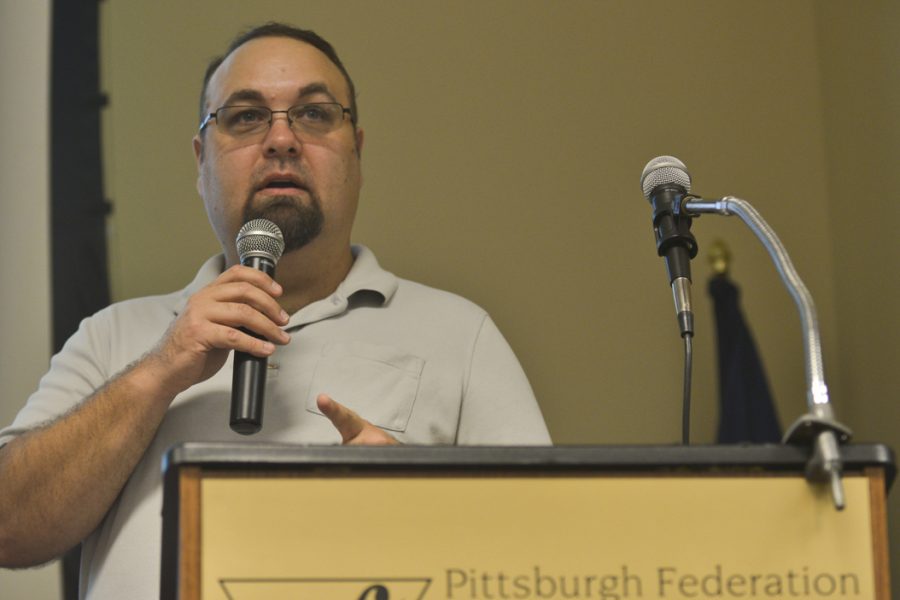Adding to the 170 wired body cameras Pittsburgh police are already wearing, the Bureau said at a public safety meeting Wednesday that it ordered another 500 wireless body cameras to use in the coming year.
The new cameras have higher video quality and storage capacity, officer Garrett Bickmore said. He added that the city’s current cameras attach to the collar and wire to the belt and pose a danger of catching on something.
The new body cameras are an Axon Body 2 model, made by Taser — a company that designs and sells body cameras, electrical weapons and digital evidence management solutions — and come with HD video and unlimited storage on Taser’s servers.
The city invested in the cameras as a safety measure for both the officers and the public and a measure to increase evidence necessary for use in court, Bickmore said.
There is legislation pending that would require law enforcement officers to wear body cameras. Currently, officers are not allowed to record in households.
About 130 people gathered Wednesday night at the Pittsburgh Federation of Teachers building for the semi-annual, citywide public safety meeting, which the police Bureau and Department of Public Safety hosted. There, presenters displayed new tools and technology that ranged from more body cameras for city police, to a tool that allows responders to identify the source of a fire, to online and mobile platforms that gather and respond to residential complaints.
Wendell Hissrich, public safety director in the city of Pittsburgh, opened the meeting, congratulating city safety officials for their progress, such as equipping officers with Narcan to combat overdose and increasing the spread of swift water rescue training for police and EMS.
Hissrich also talked about plans for 2017, including a Public Safety Department campaign to hire more EMTs and the commission of a fireboat.
Ken Wolfe, president of Zone 3 Public Safety Council and an organizer of the meeting, said he hopes these initiatives will encourage members of the community to become more actively involved in relationships with other residents and public safety concerns.
“More participation, that’s really what it comes down to … from regular citizens … so they are more aware of what’s going on, not only in government but also in public safety specifically,” Wolfe said.
At the nearly two-hour-long meeting, Captain David Hamburger of the Pittsburgh Fire Bureau also presented the department’s new thermal imaging camera.
The camera — a handheld device that looks like a science-fiction handgun — was developed by MSA Safety Incorporated, a public safety company based in Pittsburgh, and Hamburger demonstrated its ability to see victims through a blaze.
Pittsburgh now has one device for each of the city’s 28 fire rigs. Previously, there were only a few devices in the entire city.
Alongside the police and fire department, the third component of emergency medical services brought its own new technology to show off at the meeting.
Leonard Weiss, an emergency physician at Pitt and the city of Pittsburgh, presented PulsePoint — an app that alerts anyone who has the app to locations where cardiac arrests are occurring.
The app also includes a registry of AEDs — automated external defibrillators, medical devices which restart hearts after cardiac arrest — and their locations.
After the operator receives a 911 call, they put in an alert to both PulsePoint and the nearest ambulance so that whoever is closest to the victim — whether it be an off-duty paramedic or a bystander with the app — can assist them.
“We are basically trying to use technology to help save lives. That’s what our goal is — we’re starting with cardiac arrests and PulsePoint and AED mapping and public safety now,” Weiss said. “If we can conquer that, we’ll keep going to other things — there are other medical and non-medical emergencies that we can use technology to improve.”
The 17th Street Block Watch, a South Side neighborhood watch group, unveiled a new online platform called Nextdoor Wednesday night.
Robert Cavalier, leader of the 17th Street group, used South Side Flats as an example of what Block Watch, an online platform, can do.
Using the online medium Nextdoor, Cavalier and his neighborhood watch, have been able to quell complaints from residents over public drunkenness or house parties in the South Side, by submitting complaints that officers can respond to.
Complaints about students are resolved through universities, like Pitt or Duquesne University.
But the app’s true benefit is its encouragement to have neighbors meet each other, changing how residents — especially student residents — perceive their community by providing names and faces to the residences, according to Cavalier.
Wolfe said it’s been a long time coming to this level of efficiency.
“Normally block watches have been a telephone thing, so if you see something, there’s a telephone chain that you call that I’m calling you, you’re calling someone else, that person’s calling the next person so you know what’s going on in the community,” Wolfe said. “In the 21st century and the age of computers, Nextdoor –– the Nextdoor app –– has been the de facto.”
Allison Harnden, a nighttime economy coordinator in the Department of Public Safety, acts as a liaison between residents and businesses or students to educate people about proper conduct during nights out.
Harnden said that similar strategies in Oakland, such as the community code-enforcement group, Oakwatch, have made students more responsible in their communities.
“Because [Oakwatch has] been working on that initiative for four years now, now you have every class that’s been touched. The seniors tell the [first-years], the juniors tell the [first-years]. It’s getting reinforced that way,” Harnden said.



